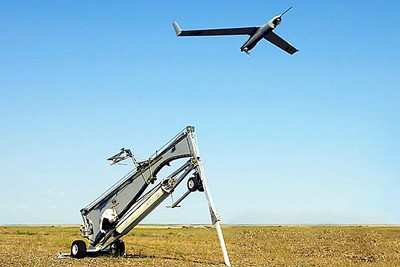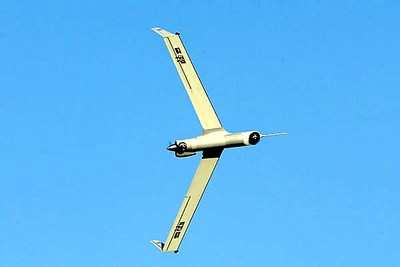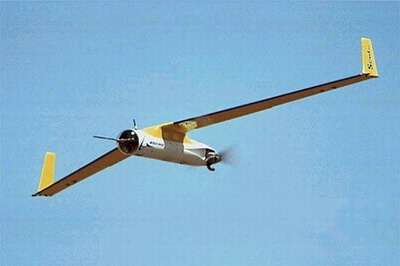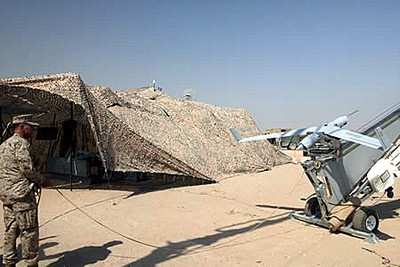Marines In Iraq Swear By Their UAVs
It's called ScanEagle, and it has already saved the lives of
many Marines.
ScanEagle is an unmanned aerial vehicle that the Marines used
during Operation Al Fajr, the coalition operation to remove
insurgents in Fallujah.

The ScanEagle system, developed by Boeing and the Insitu Group of
Bingen, WA, had its baptism of fire during some of the heaviest
urban combat Marines have been involved in since Hue City in
Vietnam in 1968. The UAV performed flawlessly, 1st Marine
Expeditionary Force officials said today.
ScanEagle is a relatively low-cost UAV at $100,000 a copy. But
it's real worth was giving Marines in Fallujah a real-time picture
of the enemy and helping them close with and kill insurgents
without becoming casualties.
Driven by a small propeller, the aircraft can stay airborne for
19 hours on just a gallon and a half of gas.
It is a "launch-and-forget" system. A catapult launches the
40-pound aircraft, and a computer operator just clicks the cursor
over the area of interest. The aircraft operates autonomously.

The cameras -- either for day or night -- have enough definition
to identify individuals and show if they are carrying weapons.
"This was a true advantage for us during the operation," said
Marine Col. John Coleman, chief of staff for the 1st Marine
Expeditionary Force. The rules of engagement were such that Marines
could not engage unless they were sure the proposed target was
carrying a weapon or intent on harming coalition forces.
ScanEagle enabled commanders to ascertain targets and provided
specific coordinates via the Global Positioning System.
The system can also track moving targets. ScanEagle gives
commanders at several different levels real-time video. With the
explosive growth of using the Web in warfare, commanders many miles
away can direct the system.

All of this is not bad for a system designed to find tuna fish.
Insitu developed the aircraft to be launched and recovered by tuna
boats. Fishermen would use the UAV to spot schools of tuna.
When the Marines needed another UAV system, they contracted with
Boeing in June 2004 for ScanEagle and the contractors to run it.
Four Boeing employees answered the call, and ScanEagles were soon
flying missions over the most dangerous city in Iraq.
The UAV is small and tough to see, said Marine officials. The
contractors put the mufflers pointing up so that the enemy couldn't
track the aircraft by sound. The Marines operate the aircraft at a
very low altitude and lost only one to enemy fire during the weeks
of intelligence gathering leading up to Operation Al Fajr.
The Marines already use the Pioneer UAV and have access to other
UAV information. The ScanEagle has a small footprint. Manning for
the system is small, and all the system needs to operate can be
carried in four Humvees.
The Pioneer, one of the oldest UAVs in the inventory, needs a
runway to operate from and several C-130s to transport the system.
And it requires 120 people to operate it.
Marine officials are impressed with the ScanEagle system, and
have shown the system's capabilities to Army, Navy and Air Force
officials.

Marine officials do not know the true extent of the system's
use. "You never really know until the Marines push the
capabilities," Coleman said. "Our young Marines are the experts.
They know what they need, and they have the knowledge to try new
methods and stretch the capabilities of most pieces of
equipment."
(ANN salutes Jim Garamone, American Forces Press
Service)
 NTSB Final Report: Rutan Long-EZ
NTSB Final Report: Rutan Long-EZ ANN FAQ: Turn On Post Notifications
ANN FAQ: Turn On Post Notifications Classic Aero-TV: ICAS Perspectives - Advice for New Air Show Performers
Classic Aero-TV: ICAS Perspectives - Advice for New Air Show Performers ANN's Daily Aero-Linx (06.28.25)
ANN's Daily Aero-Linx (06.28.25) Aero-News: Quote of the Day (06.28.25)
Aero-News: Quote of the Day (06.28.25)






